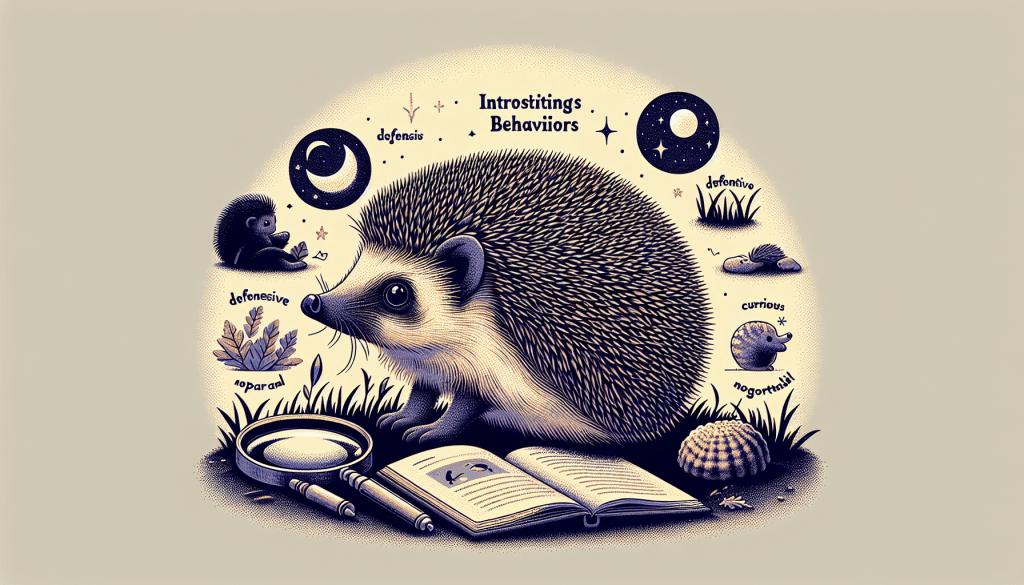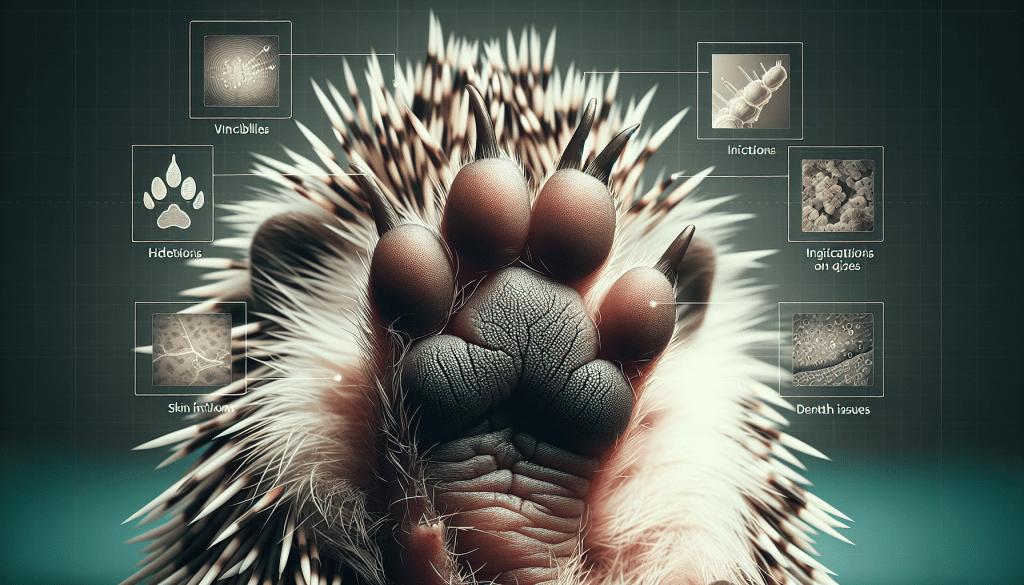Imagine stepping into the enchanting world of hedgehogs, where their behavior holds the key to unlocking the secrets behind their adorable quirks. Delve into a captivating journey that unravels the mysterious ways in which these spiky creatures communicate, express emotions, and navigate their surroundings. From their endearing self-anointing rituals to the intricate dance of their foraging techniques, delve into a world where creativity flourishes and every corner holds the promise of a delightful surprise. Embark on a quest to understand hedgehog behavior and prepare to be enchanted by the intricate tapestry of their lives.

Basics of Hedgehog Behavior
Hedgehogs are fascinating creatures with unique behaviors that make them a popular choice as pets. Understanding their behavior is crucial for their well-being and for building a strong bond with them. In this article, we will explore the basics of hedgehog behavior, from their biology and natural habits to their social behavior and communication strategies.
Understanding Hedgehog Biology and Natural Habits
Hedgehogs belong to the family Erinaceidae and are known for their spiny coats. These small mammals have a stout body covered in sharp spines or quills that serve as their primary defense mechanism. Hedgehogs have a keen sense of smell and hearing, which enables them to navigate and locate food in their environment.
In their natural habitat, hedgehogs live in burrows or nests made of leaves, grass, and other suitable materials. They are primarily nocturnal and have adapted to a nocturnal lifestyle, venturing out at night in search of food. Hedgehogs are opportunistic eaters and will consume a variety of foods, including insects, small vertebrates, fruits, and plants.
Comparing Domesticated vs. Wild Hedgehog Behaviors
Domesticated hedgehogs exhibit behavior patterns that differ from their wild counterparts. While wild hedgehogs are more cautious and defensive, domesticated hedgehogs are generally more accustomed to human interaction and may display friendlier behaviors. However, it’s essential to remember that individual hedgehogs may have their own unique personalities and may still exhibit some natural behaviors despite domestication.
Domesticated hedgehogs are often more comfortable being handled and may exhibit behaviors like snuggling up to their owners or exploring their surroundings. They may also display more relaxed body language compared to wild hedgehogs. However, it’s important to provide them with a suitable environment that mimics their natural habitat and allows for their instinctual behaviors.
Recognizing the Signs of a Healthy and Active Hedgehog
Keeping an eye on your hedgehog’s behavior is crucial for monitoring its well-being. A healthy hedgehog will be active and alert, displaying curiosity towards its surroundings. It should move around the enclosure or habitat confidently and interact with toys or enrichment activities.
A healthy hedgehog should have a good appetite and show interest in its food. It’s important to observe its eating habits and ensure it is consuming an appropriate diet. Additionally, hedgehogs should have regular bowel movements and appear physically clean, as excessive grooming or soiling may be signs of underlying health issues.
If you notice any sudden changes in behavior, such as lethargy, loss of appetite, or unusual vocalizations, it is important to consult a veterinarian to rule out any potential health concerns. Regular vet check-ups are also crucial for maintaining your hedgehog’s overall health and well-being.
Social Behavior
Hedgehogs may be solitary animals in the wild, but they still exhibit various social behaviors. Understanding their social structure and interactions can help create a suitable environment for your pet hedgehog and foster a positive relationship.
Identifying Social Structures in Wild Hedgehogs
While hedgehogs tend to be solitary, they may occasionally share territories with other hedgehogs. However, they will usually avoid direct contact and establish individual feeding and nesting areas. Hedgehogs communicate through scent marking to establish boundaries and indicate their presence to other hedgehogs.
Interaction with Other Hedgehogs
In the wild, hedgehogs may come into contact with each other during the mating season. Male hedgehogs may engage in aggressive behaviors, such as sparring, to establish dominance and court females. However, after mating, they will go their separate ways, and the female will raise the offspring independently.
Bonding with Humans: How Hedgehogs Behave with Their Owners
Domesticated hedgehogs can form bonds with their human owners. However, it’s important to be patient and provide a suitable environment for them to feel safe and secure. Hedgehogs may take some time to adjust to human interaction and may initially display defensive behaviors, such as curling into a ball or hissing.
Building trust with your hedgehog involves regular, gentle handling and positive reinforcement. Over time, your hedgehog may become more comfortable with you and may show signs of affection, such as snuggling up to you or seeking your proximity. Remember that every hedgehog is unique, and it’s essential to respect their boundaries and individual preferences.

Feeding Behavior
Understanding the feeding behavior of hedgehogs is crucial for meeting their nutritional needs and ensuring their well-being. Hedgehogs have specific dietary preferences and feeding habits that vary between their wild and domesticated counterparts.
Common Dietary Preferences and Feeding Habits
In the wild, hedgehogs are opportunistic omnivores and consume a varied diet to meet their nutritional requirements. They primarily feed on insects, small invertebrates, and plant matter, including fruits, berries, and seeds. Hedgehogs use their keen sense of smell to locate food and have strong jaws and teeth adapted for crushing and grinding.
In captivity, it’s important to provide a balanced diet that replicates their natural food sources. Commercial hedgehog food blends are available, which consist of high-quality kibble formulated specifically for hedgehogs. These blends are supplemented with insects or mealworms to mimic the natural insect intake of wild hedgehogs.
Foraging Activities in the Wild
Hedgehogs are natural foragers and spend a significant amount of time searching for food in their natural habitat. Their keen sense of smell helps them locate insects, small prey, and plant matter. Foraging provides both physical and mental stimulation and keeps hedgehogs active and engaged.
In captivity, it’s important to provide opportunities for foraging to prevent boredom and promote natural behaviors. Scatter feeding, where food is spread throughout the enclosure, can encourage your hedgehog to use its natural instincts to search for and consume food.
Feeding Routines for Pet Hedgehogs
Establishing a regular feeding routine is essential for maintaining a healthy relationship with your pet hedgehog. Hedgehogs are generally nocturnal, so feeding them in the evening or at night aligns with their natural behaviors. Providing a consistent feeding routine can help regulate their digestion and prevent obesity.
It’s important to monitor your hedgehog’s weight and adjust the amount of food accordingly. Hedgehogs are prone to obesity, which can lead to various health issues. Consult with a veterinarian to determine the appropriate portion sizes and feeding frequency based on your hedgehog’s age, weight, and overall health.
Defensive Mechanisms
Hedgehogs have unique defensive mechanisms that help protect them from potential threats. Understanding these mechanisms can prevent unnecessary stress and ensure the safety of both wild and domesticated hedgehogs.
Rolling into a Ball: When and Why Hedgehogs Do This
When hedgehogs feel threatened or frightened, they have the remarkable ability to roll into a tight ball to protect their vulnerable body parts. This defensive behavior is essential for their survival as it exposes only their spines, ensuring their vital organs remain shielded.
Hedgehogs will roll into a ball as a response to perceived danger, whether it’s a potential predator or a source of stress. It’s important to provide a safe and secure environment for domesticated hedgehogs to minimize the need for this defensive mechanism.
Use of Spines as a Defense Strategy
Hedgehogs’ spines are their most distinctive feature and serve as an effective defense strategy. When threatened, hedgehogs will raise their spines, making themselves appear larger and more intimidating to potential predators. The sharp spines act as a deterrent, making it difficult for predators to attack or handle the hedgehog.
It’s essential to handle domesticated hedgehogs with care to avoid injury. While their spines are not poisonous or barbed, they can still be painful if mishandled. Always approach your hedgehog with gentle movements and avoid any sudden actions that may startle them.
Behavioral Signs of Fear and Stress
Hedgehogs may display various behavioral signs when they feel fearful or stressed. These signs may include curling into a ball, hissing, or even becoming aggressive. Additionally, they may exhibit defensive behaviors like biting or lunging if they feel threatened or cornered.
It’s important to provide a calm and quiet environment for your hedgehog to reduce stress levels. Avoid sudden loud noises or drastic changes in their environment that may trigger fear or anxiety. Regular handling, positive reinforcement, and a suitable habitat can help minimize stress and promote overall well-being.

Hibernation and Estivation
Hedgehogs have unique adaptations for coping with seasonal changes and periods of adverse environmental conditions. Understanding their hibernation and estivation behaviors is crucial for providing appropriate care and ensuring their well-being.
Understanding the Hibernation Cycle
In cold climates, hedgehogs undergo hibernation during the winter months to conserve energy and survive when food sources are scarce. During hibernation, hedgehogs experience a significant drop in their body temperature and metabolic rate, entering a state of torpor. This allows them to reduce their energy expenditure and survive on their fat reserves.
It’s important to note that not all hedgehogs hibernate, and this behavior can be influenced by various factors, including the ambient temperature and availability of food. In captivity, it’s crucial to maintain a stable and warm environment to prevent your hedgehog from entering hibernation unintentionally.
The Impact of Temperature on Hedgehog Behavior
Temperature plays a crucial role in hedgehog behavior and physiology. Hedgehogs are ectothermic, meaning their body temperature fluctuates with their environment. Extreme temperatures can have adverse effects on their well-being, and both extreme heat and cold can be detrimental to their health.
In colder temperatures, hedgehogs may seek shelter and pile up leaves or other materials to insulate themselves. During excessively hot temperatures, hedgehogs may become inactive and seek shade or cool areas to prevent overheating.
Signs and Preparation for Hibernation in Captivity
If you live in an area with cold winters, it’s important to be aware of the signs that your hedgehog may be preparing to hibernate. These signs can include decreased activity, decreased appetite, and weight loss. Monitoring your hedgehog’s behavior and environment is crucial to prevent unintentional hibernation.
To prevent hibernation, provide a consistently warm environment for your hedgehog, using a heating pad or keeping their enclosure in a temperature-controlled room. It’s also important to maintain a consistent light-dark cycle and ensure they have a well-balanced diet to provide sufficient energy during the winter months.
Reproductive Behavior
Hedgehogs have fascinating reproductive behaviors that occur during specific periods, and understanding these behaviors is essential for any owner or enthusiast. From mating rituals to nesting habits and mother-offspring interactions, reproductive behavior plays a crucial role in the survival and propagation of hedgehog species.
Mating Rituals and Courtship Behaviors
Hedgehogs have specific mating rituals and courtship behaviors that occur during the breeding season. Male hedgehogs may engage in courtship displays, such as circling, chasing, and vocalizations, to attract females. Once a female accepts a male’s advances, mating occurs.
It’s important to note that breeding hedgehogs should be handled with care, as males can sometimes become aggressive during the mating process or territorial disputes. Proper planning and responsible breeding practices can help ensure the health and well-being of both the parents and their offspring.
Nesting Habits of Expectant Mothers
After mating, female hedgehogs will build nests in preparation for the arrival of their offspring. They will collect suitable materials, such as leaves, grass, and twigs, to create a warm and secure environment for their young. The nests are typically located in hidden areas, such as dense vegetation or burrows.
During this time, it’s important to provide expectant mothers with a comfortable and undisturbed environment. Minimizing stress and providing nesting materials will help ensure the well-being of both the mother and her offspring.
Caring for the Young: Mother-Offspring Interactions
Hedgehog mothers play a crucial role in the upbringing and care of their young. After giving birth, the mother will nurse her offspring, providing them with the necessary nutrients for growth and development. She will also keep the nest clean and defend her young from potential threats.
It’s important to provide a safe and secure environment for mother hedgehogs and their young. Avoid disturbing the nest unless it is absolutely necessary, as excessive handling or disturbance can cause stress and potentially lead to abandonment or neglect.
Nocturnal Activities
Hedgehogs are primarily nocturnal animals, meaning they are more active during the night and rest during the day. This behavior is influenced by both their natural instincts and their adaptations to their environment.
Nighttime Behavior Patterns
Hedgehogs exhibit various behaviors during their nighttime activities. They will typically venture out of their nests or hiding places to search for food, explore their surroundings, and engage in other natural behaviors like foraging or exercising. They rely on their keen sense of smell and hearing to navigate and locate food in the darkness.
Adaptations for Nocturnal Living
Hedgehogs have made various adaptations to their nocturnal lifestyle. Their eyesight is optimized for low-light conditions, allowing them to navigate and locate prey or food sources in darkness. Their spines provide protection when moving through dense vegetation or encountering potential threats.
To support their nocturnal activities, it’s important to provide a suitable habitat that mimics their natural environment. This includes providing hiding places, such as tunnels or hideouts, and ensuring the enclosure is dark and quiet during their active hours.
Impact of Domestication on Natural Circadian Rhythms
Domestication can have an influence on the natural circadian rhythms of hedgehogs. Some domesticated hedgehogs may adjust their activity patterns to align with their owners’ schedules, becoming more active during the evening or early morning hours when they are more likely to receive attention and interaction.
It’s important to understand and respect your hedgehog’s natural behavioral patterns while also providing appropriate mental and physical stimulation during their active hours. Maintaining a consistent light-dark cycle can also help regulate their natural circadian rhythms.
Communication and Vocalizations
Hedgehogs may not be known for their vocalizations, but they use a combination of sounds, body language, and scent marking to communicate with each other and their surroundings.
Understanding Hedgehog Sounds and Noises
While hedgehogs are generally quiet animals, they do produce a range of sounds to express certain emotions or communicate specific messages. They may emit low-frequency grunts or snuffles to express contentment, while hissing or snorting typically indicates fear or anger. It’s essential to be attentive to these vocalizations to understand your hedgehog’s mood and overall well-being.
Body Language and Its Meanings
Hedgehogs also communicate through body language, displaying certain postures and movements to convey their emotions or intentions. For example, when feeling threatened, a hedgehog may curl into a ball, raise its spines, or hiss to signal a warning. Conversely, relaxed body language, such as uncurling and exploring its environment, often indicates a hedgehog’s comfort and curiosity.
Observing your hedgehog’s body language can provide valuable insights into its feelings and help you respond appropriately. Being aware of their postures and movements can assist in preventing unnecessary stress or potential aggression.
Scent Marking and Its Role in Hedgehog Interaction
Hedgehogs rely heavily on scent marking to communicate with other hedgehogs and mark their territories. They have scent glands located on their underbellies, which they use to leave their signature scent on objects or areas. This scent serves as a means of identification and signaling their presence to other hedgehogs.
In captivity, hedgehogs may also exhibit scent-marking behaviors, including rubbing their body or objects against surfaces or items within their enclosure. This behavior is a natural instinct and helps them establish familiarity and a sense of ownership over their environment.
Play and Enrichment
Play behavior is an essential part of a hedgehog’s life, providing both physical exercise and mental stimulation. Understanding their play behaviors and providing appropriate enrichment activities is crucial for their overall well-being.
Types of Play Behavior Observed in Hedgehogs
Hedgehogs exhibit various play behaviors that are both entertaining to observe and crucial for their physical and mental health. They may engage in activities like running on a wheel, burrowing, or exploring their environment. They also enjoy playing with toys, such as tunnels, puzzle feeders, or balls.
Evaluating your hedgehog’s play preferences and providing suitable toys or activities can help keep them engaged and active. It’s essential to select toys that are safe, sturdy, and appropriate for their size and natural behaviors.
Enrichment Activities for Hedgehogs in Captivity
Enrichment activities are essential for providing mental stimulation and preventing boredom in captive hedgehogs. These activities mimic the natural environment and behaviors of hedgehogs, keeping them physically and mentally engaged.
Some effective enrichment activities for hedgehogs include providing hiding places, such as tunnels or cozy houses, offering different textures and substrates to explore, and incorporating puzzle feeders or treat-dispensing toys to encourage natural foraging behaviors.
The Importance of Physical and Mental Stimulation
Physical and mental stimulation are crucial for the overall well-being of hedgehogs. Engaging in play and enrichment activities helps keep them physically active, prevents obesity, and promotes muscle tone. Mental stimulation can prevent boredom and potential behavioral issues that may arise from a lack of mental engagement.
It’s important to dedicate time each day to interact with your hedgehog and provide opportunities for physical exercise and mental stimulation. Engagement through play, handling, or training sessions can strengthen the bond with your hedgehog and ensure their overall happiness and well-being.
Common Behavioral Problems
Like any other pet, hedgehogs may occasionally exhibit behavioral problems that require attention and resolution. Understanding the causes of these problems and taking appropriate measures can help address and prevent them.
Aggression and Biting: Causes and Prevention
Aggression and biting can occur in hedgehogs, and there are multiple factors that may contribute to these behaviors. These factors can include territorial instincts, fear, stress, or discomfort. It’s important to identify the underlying cause of aggression and work towards addressing it.
To prevent aggression or biting, it’s crucial to provide a suitable and stress-free environment for your hedgehog. Avoid sudden and excessive handling, respect their boundaries and individual preferences, and maintain a consistent routine and environment. Consulting with a veterinarian or animal behaviorist can provide further insights and guidance on addressing aggression.
Overgrooming and Self-Mutilation
Overgrooming, often referred to as barbering, can occur in hedgehogs, causing them to excessively groom and sometimes self-mutilate. This behavior can be triggered by various factors, including stress, boredom, or skin irritations. Overgrooming can lead to skin issues and require veterinary attention.
To prevent overgrooming, provide a suitable environment with ample physical and mental stimulation. Regular interactions and play sessions can help prevent boredom and reduce stress levels. Monitoring your hedgehog for any signs of skin irritations or discomfort is also crucial in preventing overgrooming behaviors.
Behavior Changes and When to Consult a Vet
If you notice any sudden and significant behavior changes in your hedgehog, it is essential to consult a veterinarian. Changes in behavior, such as lethargy, loss of appetite, excessive vocalizations, or unusual aggression, can be indicators of underlying health problems.
A veterinarian specializing in exotic or small mammals can properly assess your hedgehog’s health and behavior and recommend appropriate diagnostic tests or treatments. Early detection and intervention can often lead to successful outcomes and ensure the overall well-being of your hedgehog.
In conclusion, understanding hedgehog behavior is essential for providing optimal care and fostering a positive relationship with these unique creatures. From their biology and natural habits to their social behavior and communication strategies, each aspect of hedgehog behavior contributes to their overall well-being and happiness. By providing a suitable environment and engaging in appropriate interactions and enrichment activities, you can ensure the health and happiness of your pet hedgehog.


